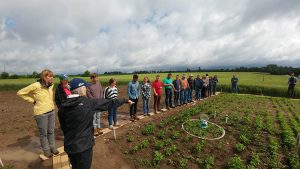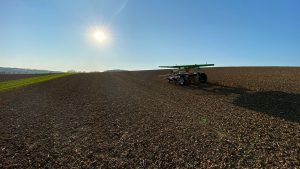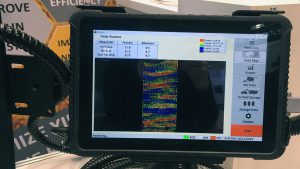Water management
THE ROLE OF FARM DRAINAGE
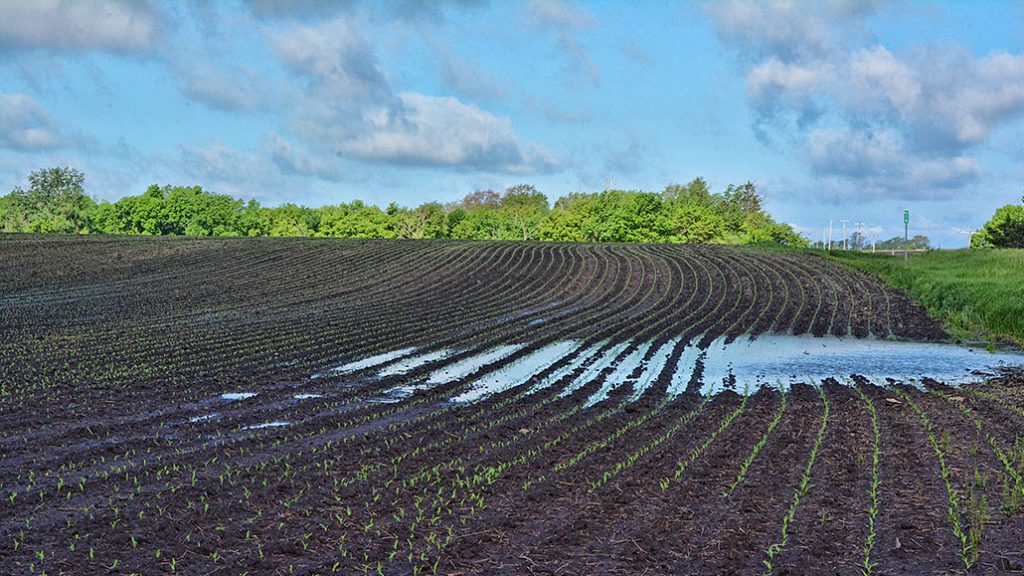
Water is a precious resource. The success of farm businesses and the health of our families depend on having a clean and abundant supply. Historically, agricultural technology has allowed us to manipulate the quantity and quality of water supplies to increase productivity. Today, this continues, with new technologies and a better understanding of natural processes. This article is the second in a series focusing on modern management of water for grain farms. Go to www.ontariograinfarmer.ca for more information and previous articles.
FARMERS REGULARLY OBSERVE the improved productivity in dry farm fields that are unhindered by wet soil conditions in contrast to wet fields. To improve productivity, farm drainage involves the creation of surface runoff channels or subsurface drainage conduits (tile) to lower the water table and improve growing conditions for agriculture. Drainage alters several elements of the water cycle, including the amount of water storage/flows on the surface and in the near-surface areas. Image 1 identifies various water cycle elements that are affected to various degrees by tile drainage.
Near-surface drainage tiles are the most common form of drainage. These are typically installed between two and three feet (60-90 cm) deep. At this depth, excess water is removed effectively from the root zone while benefiting surface activities/operations while reducing the potential for soil compaction.
As the drainage tiles lower the water table, the tiles become less effective at removing excess water. Initially, excess water drains from directly over the tile. After this water is removed, excess water from between the tiles is drained, beginning with areas closest to the tile and eventually draining the soil farthest from the tiles. When the water table drops below the depth of the tile, the tile ceases drainage completely.
The soil below the tile remains saturated until the excess water percolates to the deep groundwater. In this manner, tile only affects the excess water retained in the soil matrix above the depth of the tile, and has no influence on deeper structures such as wells.
Soil water can be divided into three categories. Gravity water is held in large pores (macropores) and drains under the influence of gravity alone. Plant available water is held in medium sized pores and is available to plants. Water held in the smallest pores is plant unavailable water.
Water removal from the largest pores in the near-surface (less than one metre) area improves growing conditions in the root zone by establishing the natural equilibrium of soil/water/air ratio. The absence of water in these large pores allows an oxygen rich (aerobic) environment which facilitates root development, soil microbial life, and improved nutrient cycling.
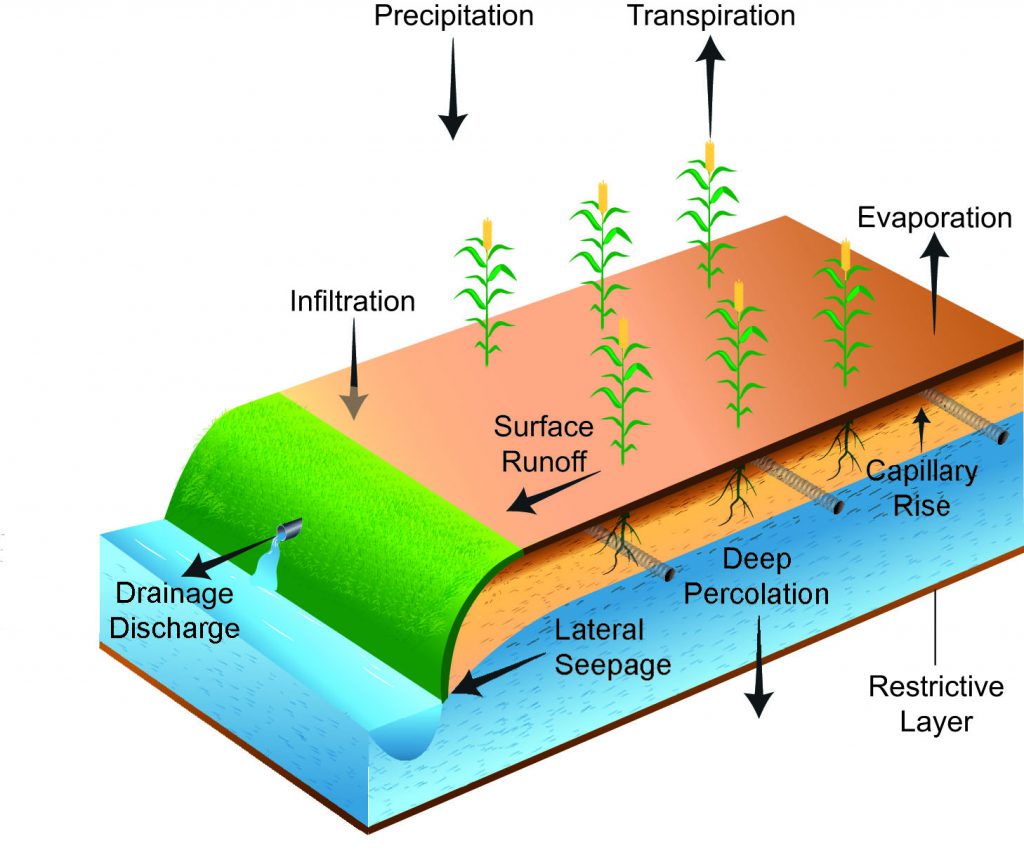
SCALE
At a small scale, tile drainage lowers the water table by creating an artificial outlet two to three feet below the soil surface. Tile allows that drainage of the gravity water from only the largest pores (macropores). Soil moisture remains the same in all of the pores smaller than these macropores. To conceptualize this, one can imagine a saturated sponge soaking in a pail of water. When the sponge is lifted from the water, water immediately drains under gravity from the largest pores. A large amount of water can remain in the sponge held by smaller pores. Tiles act in the same manner to drain the gravity water from the soil matrix and not affect the plant available water.
Tile drainage is not uniformly successful in all field conditions. Some soils which have greater macropore volume tend to have better internal natural drainage. Sandy soils drain fastest in contrast to heavy clay soils which drain slowest. All other soils drain between these two extremes based on their soil texture. Other challenges to drainage include the lack of sufficient outlet availability or capacity due to very flat land as well as shallow restrictive layers such as perched water tables caused by bedrocks, heavy clay layers, or plowpans.
At a large field or watershed scale, drainage connects various water storage (wet) areas within a field, which would not have been connected without tile. This connectivity, via the tile, reduces the water storage capacity of the near-surface component of the landscape and increases the speed at which the water leaves the near surface area. Without tile, these unconnected storage areas would have eventually drained as the gravity water slowly percolated to deep groundwater. This process usually takes weeks to months in contrast to this water leaving via the tiles which is a days to week time frame.
Near-surface water that is drained by tiles leaves the field quicker than by slow percolation to the deep groundwater storage. In some cases, this water can pickup nutrients from the surface horizons and carry them away through the drainage tile. Negative charged nutrients such as nitrate are particularly susceptible to this movement. However, during a rainfall event, the movement of water through the macropores into the tile can simultaneously facilitate the infiltration of larger amounts of surface water which would have alternatively ran over the surface if the macropores had been full.
Surface runoff tends to be poorer in water quality as it is closer to the source of nutrients in the topsoil. Incorporation of nutrients into the soil reduces the nutrients available to runoff compared to nutrients that are broadcast and not incorporated. Infiltrated water that picks up nutrients passing through the topsoil has to travel through a distance of subsoil before entering the tiles. This travel affords an opportunity for the soil to recapture (filter) the nutrients before exiting into the tiles where no further capture is possible.
The draining of excess soil water in the near-surface zone rarely reduces surface erosion alone. Surface runoff and erosion occurs when the incoming precipitation rate exceeds the infiltration rate of the soil. The infiltration rate is strongly affected by the health of the soil, which is most strongly influenced by good agronomic practices. Many Best Management Practices (BMPs) contribute to significantly improved infiltration rate, but drainage tiles alone do not improve infiltration rate. However, after installation, the tile drainage network can provide an outlet for an effective erosion control structure such as Water and Sediment Control Basin (WASCoB).
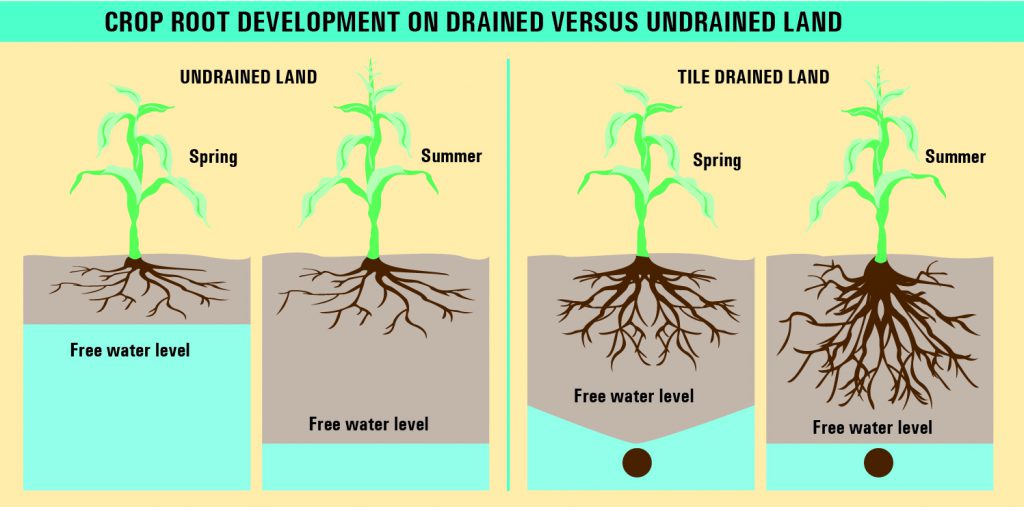
AGRONOMIC BENEFITS
Drainage tiles are an integral and critical component leading to the success of conventional, reduced, and no-till practices. Removal of surface water allows the surface horizons to warm and dry quicker. This is a huge benefit given that no-till systems leave considerable residue on the surface, which block the sun from reaching the bare soil, and reduces warming. Better drained soils, combined with greater surface residue, can result in improved trafficability with reduced chance of soil compaction.
The lowering of the water table during early crop development encourages the roots to grow deep and early. In this manner, a greater volume of soil can be accessed by the roots for improved water and nutrient assimilation throughout the season, as shown in Image 2.
There are several cases where this may be important to maintain yield stability. Sandy soils where plant available water holding capacity is more limited than in heavier soils may benefit from this greater root penetration. Root penetration in dry years can be greater than in wet years as roots are forced to grow to moisture. Wet springs reduce early season root mass development which can have severe repercussions if the remainder of the year is dry. Drainage helps to encourage this larger root mass development in the spring. This greater rootzone is insurance for yield stability through improved water and nutrient scavenging throughout out the season.
Irregular shapes and sizes of natural watersheds and watercourses, compounded by the regular shape of farm fields, can bring challenges regarding water movement between adjacent farm properties. Information provided by OMAFRA can assist in the resolution of these challenges: www.omafra.gov.on.ca/english/engineer/facts/98-015.htm
Other articles in the series:
• Producing the best grain crop possible (September 2020)
• The water cycle and why should we care (October 2020)
• The role of farm drainage (November 2020)
• Improvements through soil health (December 2020)
• A second look at farm drainage (January 2021)
• Is irrigation of grain crops feasible (February 2021)
• Irrigation case study (March 2021)
• Understanding groundwater (April/May 2021)
This article was written with contributions from Jacqui Empson-Laporte (OMAFRA), Peter Doris (OMAFRA), and Chris Van Esbroeck (Maitland Valley Conservation Authority). •









